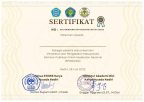EFFECTIVENESS OF KABARI (PICTURE CARDS AND STORYTELLING VIDIO) ON THE DANGER OF SMOKING ON CHANGES IN PERCEPTIONS OF THE DANGER OF SMOKING IN CLASS VIII ADOLESCENTS (at SMPN 1 NGANTRU)
Keywords:
KABARI, Perceptions of the Dangers of Smoking, AdolescentsAbstract
Teenagers have different perspectives about the dangers of smoking. The solution to increase perceptions about the dangers of smoking in adolescents is KABARI. This research aimed to determine the influence of KABARI on changes in perceptions about the dangers of smoking in class VIII adolescents at SMPN 1 Ngantru. The method chosen was an experimental research design with a pretest-posttest control group design approach. The population of 44 respondents using total sampling obtained 2 groups, namely 22 respondents in the control group and 22 respondents in the treatment group. The data were analyzed using Wilcoxon and Mann-Whitney tests. The results showed before the ability to prevent in the control group without intervention most (72.7%) were in the less criteria, while in the treatment group before and after being given the intervention most (68.2%) experienced an increase in a good perception. The results of the analysis of Mann Whitney showed that p-value 0.000 < α 0.05, meaning there is an influence of KABARI on changes in perceptions about the dangers of smoking. KABARI improves adolescents' perceptions by providing stimulation to the brain through the senses of the eyes and ears, in addition to that, the attractive appearance of KABARI using small groups in discussions makes teenagers more able to concentrate and stimulation is easy to do. Teenagers are expected to continue to improve their perceptions and love themselves more so as not to fall into bad things. These picture cards and video storytelling should be used as an alternative to increasing adolescents' perceptions and knowledge about the dangers of smoking.
Downloads
Published
Issue
Section
License
Copyright (c) 2024 Proceedings of the National Health Scientific Publication Seminar

This work is licensed under a Creative Commons Attribution 4.0 International License.







